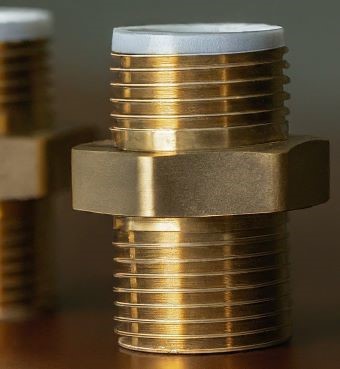When it comes to plumbing and gas lines, a secure connection is paramount. Leaks can not only waste water or gas, but also pose serious safety hazards. That’s where thread sealants for brass fittings come in. These materials fill microscopic gaps, ensuring a watertight seal and a gas-tight one.
But with various sealants available, choosing the right one can be confusing. This guide will explore the top thread sealants for brass fittings and help you pick the perfect option for your needs.
Understanding Thread Sealants for Brass Fittings
Brass fittings rely on tapered threads to create a tight seal. However, these threads can have tiny imperfections. They can allow leaks, especially over time. Thread sealants fill these gaps and create a smooth, leak-proof connection. They exist in a variety of forms, each with pros and cons of their own.
Top Thread Sealant Recommendations
A. Teflon Tape:
➡️ Applications: Ideal for low-pressure applications like water lines due to its ease of use and low cost.
➡️ Pros: Easy to apply, readily available, inexpensive.
➡️ Cons: Not suitable for high-pressure or gas lines, can degrade over time, multiple wraps needed for thicker threads.
B. Pipe Dope (Thread Compound):
➡️ Applications: A good choice for general-purpose plumbing applications and works well with slightly irregular threads due to its filling properties.
➡️ Pros: Fills gaps between threads, versatile for various materials, easy to use.
➡️ Cons: Can dry out and crack over time, may not be suitable for high-pressure gas lines.
C. Anaerobic Sealants:
➡️ Applications: The go-to choice for high-pressure applications and gas lines due to their exceptional sealing strength.
➡️ Pros: Creates a very strong, leak-proof seal, resistant to vibrations and chemicals.
➡️ Cons: Requires clean, dry surfaces for proper adhesion, has a curing time, can be messy to apply.
Also, check out these ⬇️⬇️⬇️
NPT Vs NPS: A Comprehensive Comparison
NPT Vs BSP: Industry Standards Compared
Choosing the Right Sealant for Your Needs
When selecting a thread sealant, consider these key factors:
➡️ Pressure Rating: Choose a sealant that can withstand the maximum pressure of your application (water or gas).
➡️ Application: Low-pressure water lines can use Teflon tape, while high-pressure gas lines require anaerobic sealants. Pipe dope offers a good middle ground.
➡️ Material Compatibility: Ensure the sealant is compatible with both the brass fitting and the pipe material.
Additional Tips:
➡️ Always follow the manufacturer’s instructions for proper application of each sealant.
➡️ Wrap Teflon tape in the same direction as the threads being screwed together.
➡️ Apply pipe dope sparingly, avoiding the threads’ leading edge to prevent clogging.
➡️ Clean and dry surfaces before using anaerobic sealants for optimal adhesion.
Safety Precautions
Safety is paramount when working with plumbing and gas lines. It’s crucial to remember the following:
➡️ Follow Instructions: Always adhere to the manufacturer’s instructions for each sealant, especially regarding cure times and safety precautions.
➡️ Ventilation: Certain sealants, particularly anaerobic varieties, may emit fumes. Ensure proper ventilation when using them.
Conclusion
Teflon tape, pipe dope, and anaerobic sealants each have their place when it comes to sealing brass fittings. Understanding their strengths and weaknesses is key. Consider the pressure rating and application. Then, you can choose the best sealant for your needs.
Remember, prioritize safety by following instructions and using proper ventilation. With the right knowledge and tools, you can ensure watertight and gas-tight connections for your brass fittings.
Post time: Jun-14-2024


